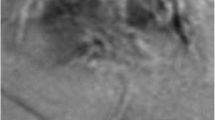Abstract
For more than a century, it has been known that juvenile idiopathic arthritis (JIA) can affect the temporomandibular joint. With advances in medical imaging in more recent decades, there has been an increase in awareness of the spectrum of pathology that can affect the temporomandibular joint in children with JIA. This pathology can lead to symptoms ranging from decreased chewing ability, jaw and facial pain, headaches and malocclusion to craniofacial morphological changes such as a retrognathic mandible. The purpose of this review is to suggest an MR imaging protocol for the temporomandibular joint and to illustrate normal and abnormal appearances of the joint in children with JIA.
















Similar content being viewed by others
References
Still G (1941) On a form of chronic joint disease. Arch Dis Child 16:156–165
Billiau AD, Hu Y, Verdonck A et al (2007) Temporomandibular joint arthritis in juvenile idiopathic arthritis: prevalence, clinical and radiological signs, and relation to dentofacial morphology. J Rheumatol 34:1925–1933
Sidiropoulou-Chatzigianni S, Papadopoulos MA, Kolokithas G (2009) Dentoskeletal morphology in children with juvenile idiopathic arthritis compared with healthy children. J Orthod 28:53–58
Kuseler A, Pedersen TK, Gelineck J (1998) Contrast enhanced magnetic resonance imaging as a method to diagnose early inflammatory changes in the temporomandibular joint in children with juvenile chronic arthritis. J Rheumatol 25:1406–1412
Ringold S, Cron RQ (2009) The temporomandibular joint in juvenile idiopathic arthritis: frequently used and frequently arthritic. Pediatr Rheumatol 7:11
Georgios K, Helias A, Athanassios K et al (2009) Craniofacial surgical management of a patient with systematic juvenile idiopathic arthritis and Crohn’s disease. J Craniofac Surg 20:948–950
Kofod T, Nørholt SE, Pedersen TK et al (2005) Unilateral mandibular ramus elongation by intraoral distraction osteogenesis. J Craniofac Surg 16:247–254
Argyropoulou MI, Margariti PN, Karali A et al (2009) Temporomandibular joint involvement in juvenile idiopathic arthritis: clinical predictors of magnetic resonance imaging signs. Eur Radiol 19:693–700
Towbin R, Chao CP, Caplin D et al. (2010) ACR-SIR practice guideline for sedation/analgesia. http://www.acr.org/~/media/ACR/Documents/PGTS/guidelines/Adult_Sedation.pdf. Accessed 6 May 2013
Cotes J, Wilson S (2006) Guidelines for monitoring and management of pediatric patients during and after sedation for diagnostic and therapeutic procedures: an update. Pediatrics 118:2587–2602
Aiken A, Bouloux G, Hudgins P (2012) MR imaging of the temporomandibular joint. Magn Reson Imaging Clin N Am 20:397–412
Hayt MW, Abrahams JJ, Blair J (2000) Magnetic resonance imaging of the temporomandibular joint. Top Magn Reson Imaging 11:138–146
Roth C, Ward RJ, Tsai S et al. (2005) MR imaging of the TMJ: a pictorial essay. App Radiol. http://www.appliedradiology.com/Issues/2005/05/Articles/MR-imaging-of-the-TMJ--A-pictorial-essay.aspx. Accessed 22 January 2013
Eberhard D, Bantleon HP, Steger W (2000) Functional magnetic resonance imaging of temporomandibular joint disorders. Eur J Orthod 22:489–497
Küseler A, Pedersen TK, Gelineck J et al (2005) A 2 year followup study of enhanced magnetic resonance imaging and clinical examination of the temporomandibular joint in children with juvenile idiopathic arthritis. J Rheumatol 32:162–169
Fritz J, Thomas C, Tzaribachev N et al (2009) MRI-guided injection procedures of the temporomandibular joints in children and adults: technique, accuracy, and safety. AJR Am J Roentgenol 193:1148–1154
Von Kalle T, Winkler P, Stuber T (2012) Contrast-enhanced MRI of normal temporomandibular joints in children – is there enhancement or not? Rheumatology 52:636–637
Winalski CS, Sledge B, Weissman N (1993) Enhancement of joint fluid with intravenously administered gadopentetate dilmeglumine: technique, rationale and implications. Radiology 187:179–185
Gylys-Morin VM, Graham TB, Blebea JS et al (1999) Knee in early juvenile rheumatoid arthritis: MR imaging findings. Radiology 220:696–706
Dwivde AN, Tripathi R, Gupta PK et al (2012) Magnetic resonance imaging evaluation of temporomandibular joint and associated soft tissue changes following acute condylar injury. J Oral Maxillofac Surg 70:2829–2834
Gupta VK, Mehrotra D, Malhotra S et al (2012) An epidemiological study of temporomandibular joint ankylosis. Natl J Maxillofac Surg 3:25–30
Amos MJ, Patterson AR, Worrall SF (2008) Septic arthritis of the temporomandibular joint in a 6-year-old child. Br J Oral Maxillofac Surg 46:242–243
Arabshahi B, Baskin KM, Cron RQ (2007) Reactive arthritis of the temporomandibular joints and cervical spine in a child. Pediatr Rheumatol 5:4
Conflicts of interest
None
Author information
Authors and Affiliations
Corresponding author
Additional information
CME activity This article has been selected as the CME activity for the current month. Please visit the SPR Web site at www.pedrad.org on the Education page and follow the instructions to complete this CME activity.
Rights and permissions
About this article
Cite this article
Meyers, A.B., Laor, T. Magnetic resonance imaging of the temporomandibular joint in children with juvenile idiopathic arthritis. Pediatr Radiol 43, 1632–1641 (2013). https://doi.org/10.1007/s00247-013-2769-z
Received:
Revised:
Accepted:
Published:
Issue Date:
DOI: https://doi.org/10.1007/s00247-013-2769-z




